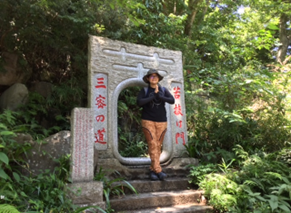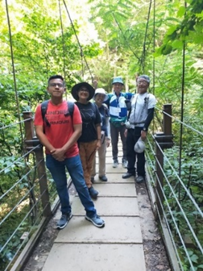Around 9:30 am on July 16th, at ticket gates of Takaosanguchi station, we, two guides, met up a woman from Singapore and Malaysian family of three. After each introduced themselves, we left for cable-car station in the lush greenery of summer.
At the statues of Japanese giant flying squirrels which is native to Japan, we explained these beloved nocturnal creatures. It has a flying membrane between its legs which is used to glide between trees. It has also a long thick tail which is used as a rudder when it glides. They eat leaves of a tree, flowers, pollen, nuts, etc. When they fly or gride, they climb tall trees and jump off from it. Their gliding distance is generally about three times the height of a point of the tree where they jump off. They could glide more than 100 meters riding the wind. They breed twice a year in spring and autumn. The rich wildlife of Mt. Takao is not limited to Japanese giant squirrels but around 30 kinds of mammals and 5000 kinds of insects. There are also 1600 kinds of plant which accounts for some 30 percent of all the plant life in Japan.
Mt.Takao offers a variety of hiking trails suitable for all levels
of hikers, from beginners to experienced trekkers. The trails almost
well-maintained, allowing visitors to immerse themselves in nature while
enjoying a leisurely or challenging hike. We planned to take cable-car to
halfway up then trail-1 visiting Yuki-en, Yakuoin temple then to the top of
Mt.Takao. From the Kasumidai observation deck, we could enjoy a wonderful view
of Tokyo including high-rise buildings in Shinjuku and Tokyo Sky Tree tower. The
height of Tokyo Sky Tree is 634 meters, which is taller than that of Mt.Takao
of 599 meters.
In front of the monkey park, we
explained the native species known as the Japanese macaque which are found in
various regions but in Hokkaido. As the unique behavior of Japanese macaques as
they soak in the hot springs to keep warm during the cold winter months. At
Mt.Takao area they are found frequently and they occasionally raid crops such
as vegetables and fruits. Measures are taken to deter monkeys from damaging
agricultural fields, such as installing electrical fences or using noise-making
devices.
Next of “jinben-do” shrine, there is the stone monument of the teaching of not taking any life. This is one of the most important teachings in Buddhism. The principle of non-harming is not limited to human life but extends to all forms of life, including animals and insects. Since Buddhism and Chinese characters came from China in the 6th century, Japanese people gradually began to avoid eating meat. After modernization of Meiji era, Japanese people start to eat meat. For Buddhist monks to keep this principle, they have a meal of Buddhist vegetarian cuisine, Shojin-Ryori. At this temple, Yakuo-in, serves Buddhist vegetarian cuisine, Shojin-Ryori.
We went on the trail-1 onto men’s slope which has 108 stairs, then Yuki-en where white structure of stupa in which Shakamuni Buddha, founder of Buddhism, was enshrined was shining in the summer sun. Walking through between large cedar trees and the wooden boards written the names who contributed to Temple, we arrived shitenno-mon gate. There are stairs to main hall where we were able to see monks going back after regular Goma Fire ritual. There are more stairs to the upper temple. We are all dripping with sweat. I learned later that the highest temperature was over 38degrees Celsius at near Hachioji-city. We arrived the top of Mt.Takao before noon. As a reward for devote to get to summit, we could look Mt.Fuji though half of it was hidden by cloud unfortunately. We took lunch at Soba noodle restaurant.
On
the way back, we took trail-4, which is a mountain path and attracts people by
suspension bridge. We took two breaks until arriving chair-lift station.
Descending by the chair lift makes us feel comfortable with gentle breeze. We
arrived at Kiyotaki-eki station around 14:30, then ended this hiking tour with
satisfaction of accomplishing something. (Comson)


















